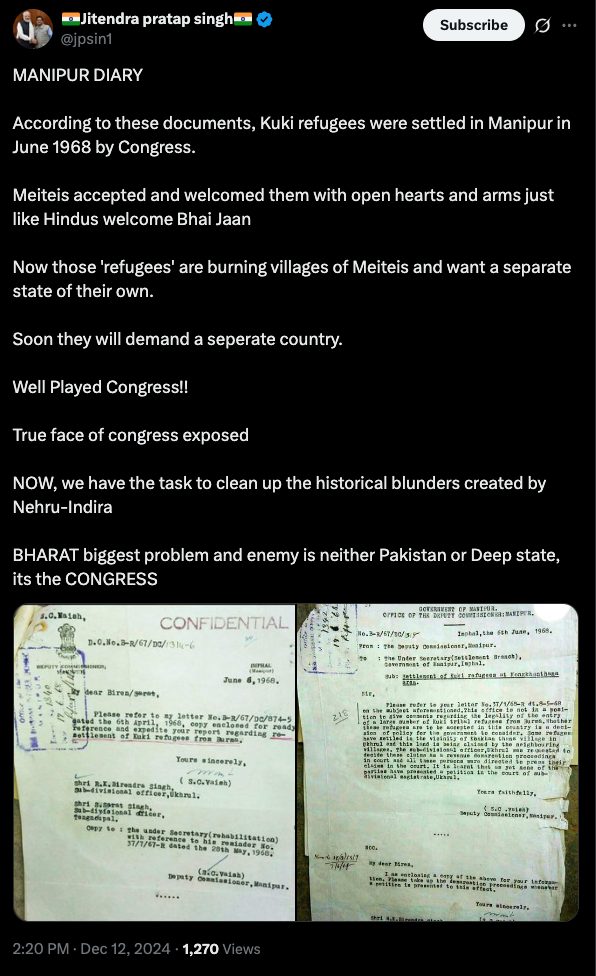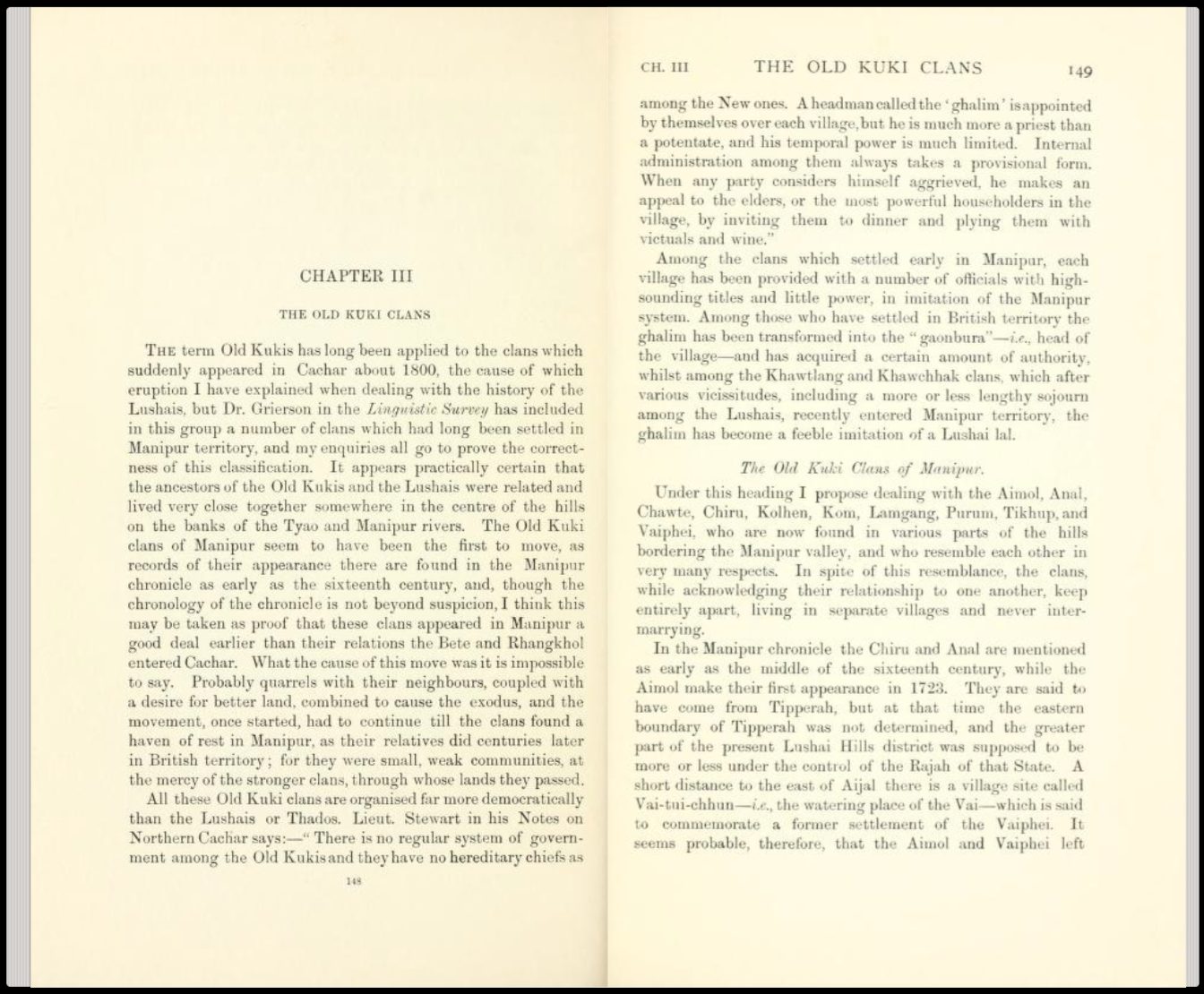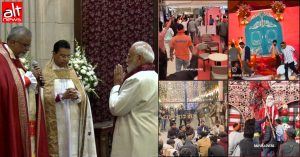Claims that Manipur’s Kuki tribe are refugees from Myanmar, welcomed to the state by the Congress government in 1968 and now have the upper hand, as they enjoy the Scheduled Tribe status, are being shared widely on social media platforms. Those making these claims have also shared some correspondence between the then-deputy commissioner of Manipur, S C Vaish, and the state government under-secretary, Birender Singh, on the “re-settlement of Kuki refugees” in certain areas.
The claims have emerged amid a stormy Monsoon Session of the Parliament, wherein Opposition leaders criticised the Centre for not addressing ethnic clashes that have erupted in Manipur since 2023 owing to conflict between the Meitei and Kuki communities. The northeastern state saw major violence and uneasy calm after the majoritarian Meitei community demanded their inclusion among the Scheduled Tribes. While this is the most recent trigger, the rift between the Kukis (primarily residing in the hills) and the Meiteis (valley residents) has been widening over decades. At present, Manipur is under President’s rule.
Coming back to the viral claims. On July 29, 2025, a Facebook user (Hiren Hindu) shared two documents claiming that Kukis were refugees who were given shelter in Manipur by Congress in 1968. This user also provocatively suggested that “sheltering Rohingyas and Bangladeshis” will eventually lead to them “occupying your houses, just like they did in Kashmir yesterday and are doing in Manipur today.”
The same documents and claims were also shared by X user (@Chhora_Up_Wala) on July 30.
कांग्रेस मणिपुर मणिपुर क्यों चिल्ला रही थी समझिए…???
क्यों की आज मणिपुर है कल पूरे देश में होना है👇 इन दस्तावेजों के मुताबिक कुकी शरणार्थियों को जून 1968 में कांग्रेस ने मणिपुर में बसाया था।
मैतेईस(हिंदुओ) ने उन्हें स्वीकार किया और खुले दिल और बांहों से उनका स्वागत किया।… pic.twitter.com/QCSimui20O
— गौरव योगी भक्त🔱 (@Chhora_Up_Wala) July 30, 2025
Alt News found that this was not the first time such claims went viral. In December 2024, X user @jpsin1 also shared these documents with similar claims to attack Congress. Note that this user has been called out on several occasions by Alt News for spreading communal misinformation.

Below are more instances of similar historical correspondence surfacing on social media since 2023.
Fact Check
The Kukis form an ethnic group that inhabits not just Manipur but several neighbouring northeastern states, such as Mizoram, Assam and Nagaland. They also inhabit certain regions of Bangladesh and Myanmar. Due to the proximity and porous borders they share with neighbouring states and countries, as well as the overlaps they have with tribes in these regions, many Kukis have often been accused of being “outsiders” in Manipur. Also, Kukis are not a unified tribe but comprise several subgroups, such as Aimol, Anal, Chawte, Chiru and Kolhen, among others. The name Kuki, too, was likely prescribed during British colonial rule.
Their historic origins and how they came to be settled during colonial rule in India require a much longer and detailed scholarly analysis, which we will not get into here. But historical records indicate that Kukis have been part of Northeast India and modern-day Manipur for hundreds of years.
One of the early records on Kukis was in a monograph by British officer Lt Col. John Shakespear in the book The Lushei Kuki clans, published in 1912 by Macmillan. Here, he says that records of appearances of “Old Kukis” in Manipur date as far back as the 16th century. He also said that they appeared in vast numbers in the Cachar region (now Assam) around 1800.

These findings have also been backed by other scholars as well as in publications by other British officers in the 19th century. (See this and this.)
Shakespear identifies the clans Aimol, Anal, Chawte, Chiru, Kolhen, Kom, Lamgang, Purum, Tikhup, and Vaiphei as Kukis found in hills bordering the Manipur valley. From the book:
“In the Manipur chronicle the Chiru and Anal are mentioned as early as the middle of the sixteenth century, while the Aimol make their first appearance in 1728.”
Additionally, Kukis also led a rebellion against the British between 1917 and 1919. Known as the Kuki Rising or the Anglo-Kuki War, the uprising was sparked, to some degree, due to the ‘forcible’ recruitment of Kukis as labour for World War I. As scholars Jangkhomang Guite and Thongkholal Haokip write in The Anglo-Kuki
war, 1917–1919 (Routledge, 2019), the “active warfare and counterinsurgency operation” that began in March 1917 went on for till May 1919, “suspending two agriculture seasons and ending with the systematic destruction of villages, properties and all sources of livelihood.”
Kukis were granted the ST status in Assam and Tripura in 1950 and 1956 under the Constitution (Scheduled Tribes) Order, 1950.
All of this makes it amply clear that Kukis inhabited the Northeast and Manipur far before 1968, unlike what the viral claims suggest.
What are the Viral Letters About?
On investigating further, we found that in 1967, the then-Burmese government had launched Operation Khadawmi to oust non-Burmese residents. As a result, thousands of villagers were pushed out of their homes because they were unable to furnish a national identity card. Among those pushed out were Kukis who migrated to the northeastern state of Manipur. Some scholars also claim that the Kukis who were pushed out of Burma in the 1960s had migrated there from the northern hills in Manipur in the late 1950s when the Naga movement started gaining momentum and several leaders of the Kuki clan began being killed.
In 2021, the Kuki National Organisation (KNO) had clarified that the Indian government had offered humanitarian aid to Kukis who fled to Manipur from Burma and that the now-viral letters were used to wrongly suggest that all Kukis were refugees.
“In 1967 during the Khadawmi operation in Burma, between Christmas and the New year, a small population of Kukis were forced to flee to Manipur. The hapless people, treated as refuges, were given humanitarian aid by the Indian Government. Government Notification (D.O. No. B-R/67/DC/1314-6, dated June 6 1968) to this effect was issued by District Commissioner Manipur. Suisa Tangkhul was the Member of Parliament from Outer Manipur at the time. The unfortunate event has been misrepresented to suggest all Kukis are refugees!” the KNO’s statement to The Frontier Manipur read.
Alt News reached out to a senior journalist from Manipur, Pradip Phanjoubam, to understand the context of these letters. Phanjoubam told us that while little is known about why some Kukis came to Manipur that year, the most likely explanation is that it was triggered by the anti-purge operation led by then Myanmar chief general Ne Win in 1967. While he said that there are some gaps in this explanation, it was most plausible.
This suggests that the letters exchanged between the then-deputy commissioner of Manipur, S C Vaish, and the state government under-secretary, Birender Singh, were possibly regarding the resettlement of these refugees from Myanmar, driven out due to the political situation there, in the Kongkhanthana area of Ukhrul in Manipur.
To sum up, while the issue of migration and repatriation of Kukis from Myanmar and their ethnicity is complex and layered, claims that all Kukis were refugees who were welcomed to Manipur in 1968 by Congress are far from true. While the documents shared by social media users do mention Kuki refugees from Myanmar settling in certain regions in Manipur (Kongkhanthana), they do not say all Kukis living in Manipur are refugees. Moreover, our findings indicate the correspondence may be referring to Kukis driven out from Myanmar in the mid-1960s amid Operation Khadawmi.
Independent journalism that speaks truth to power and is free of corporate and political control is possible only when people start contributing towards the same. Please consider donating towards this endeavour to fight fake news and misinformation.











